UPDATE 12/26/20: I screwed up. Big time. So I posted an important update at the end of this post.
“DAMN it.”
My big toe smarts…
“WHO… left the scales in the middle of the bathroom floor?!” More wail than shout.
“They’re not in the middle of the floor,” my wife says quietly behind me…
So I jump. Hitting the bastards again.
“If you need your slippers, they’re are next to your bed, hon…” Patient. She’s always so patient…
“AARGH!!!” I love my wife, I love my wife, I do, I do, I do… I love my wife…
This.
This is one reason I live alone. And design my home around my autism. And why my wife lives separate from me… even if we visit each other nearly every day. All day.
As an autist, I am challenged managing space, time, mind, heart, body, and above all… energy.
I give a LOT of details below, so here’s the short TL;DR version:
I’ve learned to improve those challenges by creating routines, organizing space, memorized “maps,” efficiency… and with some outside support from loved ones. Because how well I function varies so very wildly, it is difficult for me stick with systems through meltdowns, shutdowns, and decompensations. Even ones that help me a lot.
My awareness of surroundings varies.
Like some autists, I wake up slow. As in, sometimes it takes hours, when I’m experiencing stressful periods before I stop bumping into things, talk in more than monosyllables, have any freaking clue what’s going on…
Sometimes it seems my every quirk has an ugly psychological term, in this case, one like “confusional arousals” or “sleep drunkeness.” In fact, I have a number of parasomnias and other forms of waking, dreaming, and sleeping awareness difficulties… as well as thinking differences… from most non-autistic folk…
I am challenged by my autistic mind.
So.
I require a fair number of accommodations just to get from one end of my trailer to another. Sorta like the stereotypical “absent-minded professor.” On steroids. And just a dash of adderall.
(718) The Absent Minded Professor (1961)-Fred MacMurray, Nancy Olson, – YouTube
Over the last few months I’ve been researching how to “Me-Proof” my home. Ya know, like you might baby-proof or cat-proof an apartment to avoid disasters?
AND to “Purpose” my home. Tame it. Literally, domesticate it… to work with me, for me… and what I do in my life… instead of the other way around.
Unfortunately, I’ve found precious little on the subject… mostly from the perspective of parents who can’t communicate with their autistic kids… for a variety of reasons. (I share links I found in the notes below.)
SO… I’ve pretty much had to make it up. Or maybe, as a stubborn auto-didact (self teacher)… I just found another excuse to do things my way.
As always, please remember every autistic person is different.
These thoughts I share are based on my needs… which are also influenced by my personal, complex life, including moderate trauma as well as physical and mental co-morbidities. Your needs will be different.
But you may find… even when you disagree… that you get new ideas about designing living space for you or a loved one.
Listen… I’m not a very structured writer. Outlines? Topic sentences? Paragraphs? Seriously? Autistic much…?
I’m more image/space/story-based than outline based. So let me return to my opening story…
I head to the kitchen to make coffee… which can help speedup the process of clearing my head… down the long, narrow corridor… trailing my left fingers against the wall… through the living room… briefly touching my keyboard, a chair, my work table… into the kitchen itself… touching the table, grabbing the oven handle…
I have trouble negotiating 3D space.
I click a burner on high and turn to my coffee nook beside it. Grab my pour-over pot, a filter, then reach right into the door of the fridge to where my Bustelo espresso and half-and-half wait for me. Step two steps to the right, flick the water filter switch, fill the tea pot. Step two steps to the left and plop the pot down. Then wait for the water to just hiss…
Here I’m using “cruising” as a survival strategy… as some autists do. Maintaining my balance… and frankly my attention as well… by making sure every room has solid surfaces I can touch as I go through. (To my knowledge I’m not dyspraxic… but am definitely an adult “clumsy kid.”)

Simple frustrations can stop me from achieving even simple goals…
So I arrange my entire home in “Nooks”… places where I can find all my tools, resources, space and furniture I need for individual special interests. Without having to hunt for anything. One single-purpose nook for each interest… coffee, baking/cooking/pickling, illustrating, writing, playing & writing music, “home theater,” yoga/meditation, “workbench”… all in less than 700 square trailer feet.

Baking Nook: Everything within arm’s reach. 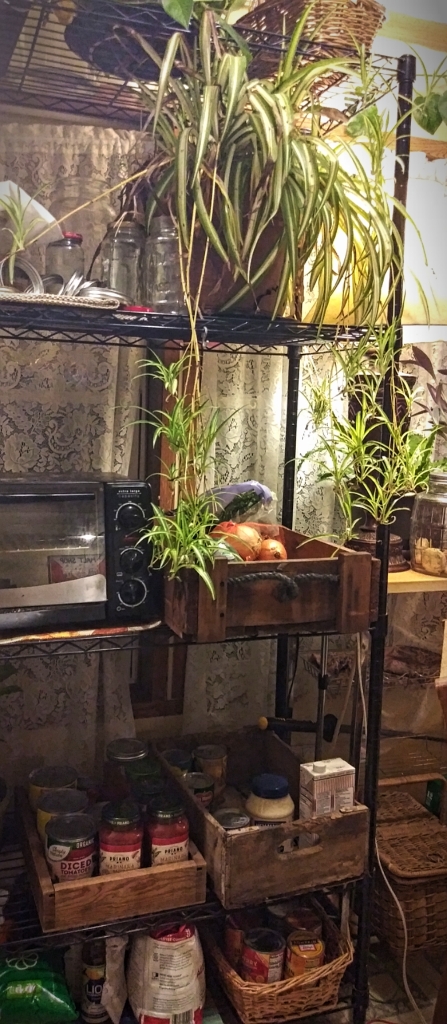
Pantry Nook: Everything visible. I always know what I have. Everything within reach. No frustrating barriers to dinner! 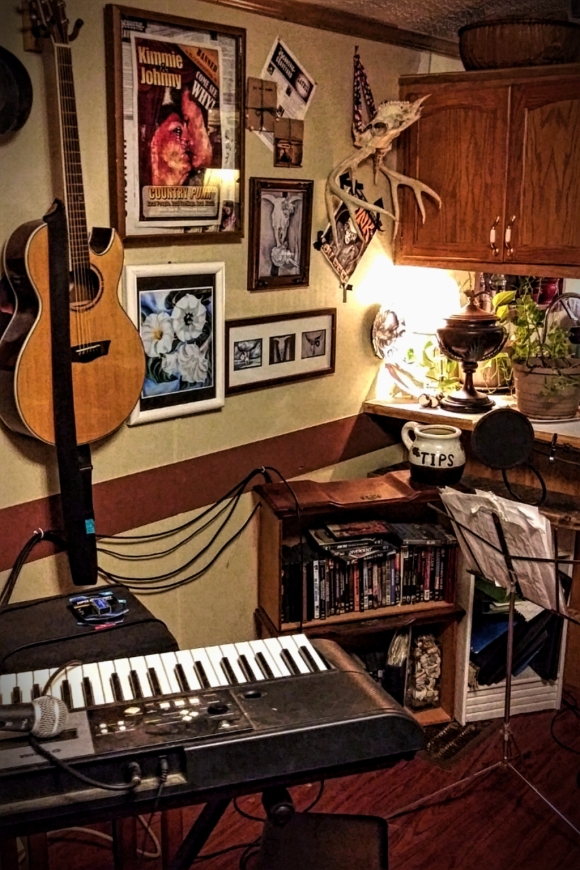
Music Nook: Everything within reach, but out of the way. Special care with instrument cables. Death to an unbalanced autistic!
Outdoors my nice-sized yard has flower nooks, a firepit nook, a container gardening nook, a tool nook, a recycling nook, a compost pile nook… oh, and a maze for the grandkids I created by mowing a small hayfield in circles, adding ornamental grasses, flowers…
Decisions are hard for me… taking tremendous energy.
Took me a lifetime to realize it. I’ve actually run a magazine, an ad agency, and a coupla nonprofits… with a LOT of staff support… and reducing as much as I could to routine, flowcharts, 3-item lists.
At one time, I prided myself on my “quick” decision making. Truth is, decisions are so hard for me… I did everything I could to avoid them. My “quick” decisions were mostly impulsive, largely functioning to quickly reduce my executive-function anxiety… frequently with poor results.
In retired life, without support staff, this is becoming more clear.
I walk to the front door… Call Buddy, take him out on the porch, put him on his cable. Go back in.
I love living things. Pets. Plants. Yeast. I surround myself with them. 3 cats. A Pit-Chihuahua dog. Vines & plants in every room. An entire fermentation nook for my living food. It seems a lot of autists have a similar love.
My mood and functional ability vary… wildly.
Because I can’t predict shutdowns or even lengthy decompensations, I need to automate care of my loved ones as much as I can.
I try to walk my dog every day… but make sure he has long cables from my two exit doors so he can get out when I have trouble getting out of bed.
I automate watering my plants so they can survive if I forget them for a few days.
Yeast and fermented pickles? Well… sometimes the lower life forms get tossed. I set up routines for demanding living things. But there are days I can’t refer to a list, schedule, or even phone alarm.
So I can’t count the number of times I’ve restarted my damn sourdough starter….
I sip my coffee… and pretend to glance at the colored index cards on my bulletin board…
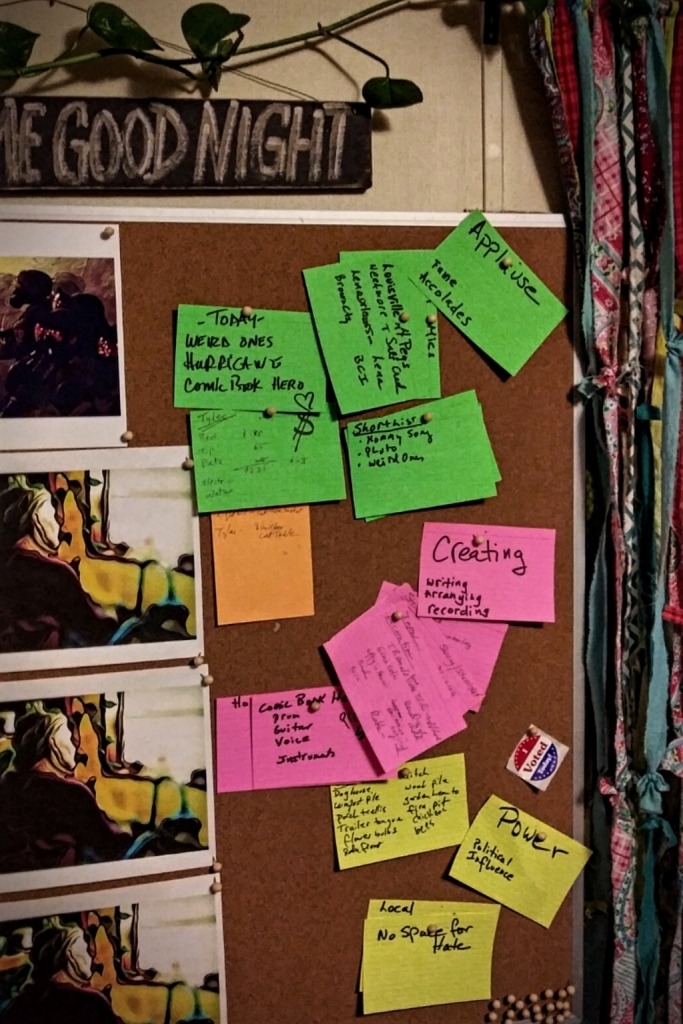
The good news? I have found after decades of trial and error… the best organization system for me.
The bad news? Not that bad, really.
I need a little help to make it work. No system helps me all THAT much without some modest outside support… a loved one or case worker “letting me do it myself” when I am functioning… helping me focus and overcome inertia when I need it… lending me energy to restart the process after I completely lose it for awhile…
Works like a champ for me with a little care & concern. Nearly always from my wife. Sometimes from a psychologist specializing in autists I see… when I can.
I tried paper planners, personal digital assistants (PDAs), elaborate todo computer applications, Getting Things Done™, electronic calendars…
Turns out…
If I can’t see it… I forget it. Soon it doesn’t exist.
and
If I can’t touch it… I don’t really understand it. Soon it doesn’t exist.
Food pantry items stored behind doors? I almost immediately forget they’re there. End up buying them over and over.
Notes, calendars, alarms stored on my phone or computer desktop? I forget them even faster than immediately.
My best system: Low-tech colored index cards on a corkboard. With big wooden pins. I can see them. I don’t have to read them to know what they’re about. I love moving them around and organizing them. I remember them. Touching them, physically writing on them… vastly improves the chances I’ll use them.
Unfortunately…
I can’t process lists longer than 3 items.
So… nix to long, written todo lists. Spreadsheets. Detailed calendars. ETC…
I can create them okay. It’s not that kind of cognitive impairment. I understand them well. I’ve always created usable lists and forms for employees, for instance.
But using them? My eyes glaze over.
And it’s true for index cards too. I can handle 3 cards (categories) okay. I can even handle up to 3 sub-cards per category… with effort & discipline. Any corkboard more complex than that?
Just so much colorful space junk… wasted on me.
I sit down at my writing desk. I flip on my desk lamp. My computer already open to the news feeds on autism I post… most days… to my Facebook groups Missing While Autistic and Trigger Warning: Autism & the Police.
My notes, phone, paper, pencils, pens, writing tools… everything I need, organized in one place.
Only one question remains…
Do I have enough energy & clarity left…
To BEGIN my day…? To accomplish ANYTHING I want to…?
Because that’s the question I must answer everyday. No matter how I plan it. No matter how I organize my home.
It’s the question facing every autist I have ever known. Every morning.
The struggle for energy and clarity are behind EVERTHING I’ve described so far about my home.
Every detail is a distraction. Every distraction saps my energy. Every decision takes time and energy.
Lost energy leads to meltdowns, shutdowns, decompensations.
Every rug or dog toy is a risk for stumbling. Every step around or over an obstacle saps my energy. And every nagging thought, “I don’t have time to move it right now… I got stuff to do… I gotta remember to do it later…”
Every undone task… gnaws at the back of my mind. Say, walking on an unswept floor all day… cuz I just gotta get other stuff done… drives me bonkers.
Every missing tool. Every tiniest obstacle. Every human interaction.
And because of all the above? Every missed goal I feel ruminative guilt over.
Each and every one of these sets off incessant, automatic backward mental processes… trying to remember, trying to decide, trying to review, trying not to self-loath, trying to prioritize, trying trying trying… instead of doing.
Every human interaction. Every word.
Leads to exhaustion. And collapse. (If you haven’t read the classic essay on disability, Spoon Theory,… now’s a good time.)
With that background and illustration, here are the organizing principles… and a number of accommodations and solutions… I’ve used for myself. Tbh, I have not been able to use these strategies in every living situation I’ve been in… all the time.
But I always keep them in mind. And try to work in their direction.
1. Every detail in my home should support my autistic life…
and that revolves around social difficulties, intense hyper-focused interests, a need for structure and routine, sensory processing difficulties, difficulties with executive functions like decisions and prioritization… and, typically, some physical or cognitive disabilities.
- My lighting can be neither too bright (especially blue, flourescent or LED light) — to avoid sensory overstimulation… nor too dark — to avoid depression. It took me years to discover the perfect solution for me is to avoid overhead light altogether… and to create bright “pools” of light with lamps in functional areas. Reading lamps, spotlight on baking counter, low-wattage bulbs on end tables…
- The QUIETER the better. I didn’t discover this til I moved to rural Indiana. So many sounds in the city were exhausting me… but I had no idea. Traffic, sirens, yelling, parades, megabass car radios… Now I turn off every fan I can, any noisy lights, turn the refrigerator as warm as possible so the fan kicks on less often. I put in heavy drapes or even block unnecessary windows to dampen traffic and neighborhood noise. When I can I hang quilts or colorful blankets… such a pleasant, cozy hush. I also have converted a small 8 x 8 “bedroom” into a blacked out, noise insulated yoga room… and safe space for when I must truly isolate.
- I thrive with lots of fresh air and outdoor activity. When I can I use air purifiers & filters. This may be due to allergies or my chronic respiratory problems. But it helps with my focus a great deal.
- Less is more. More time. More energy. More awareness for what’s importantto me. That’s why I have as few objects as I can in my home. Now, it’s not exactly a Zen desert… but I do tend toward the minimalist in my art AND life. If an object doesn’t have a use, embody a memory, or radiate enough beauty to make me feel something… Do I really need it?
2. Simple frustrations can stop me from achieving even simple goals…
3. Decisions are hard for me.
4. My awareness of surroundings varies.
My mood varies and I dissociate (space out or trance out) both of which can dim my awareness of what’s going on around me. And I am really easily bored, so I’m frequently lost in my head thinking.
I bump into things a lot. My house has to assume an autopilot role to help me.
- I tend to rely on “cognitive maps” to get around. I put furniture and floor items in logical places… and then never move them. (At least not without planning and thought.) That way, I can get from point A to point B, essentially without thinking. Like remembering to step around bathroom scales…
- I have a place in my home… and my head… for every object… and then never move it. I think of where does an object want to live? Where does it feel it belongs? Where is the first place that pops in my mind when I think of using the object? Fingernail clippers… In a hurry, I might use them anywhere in the trailer — playing guitar, sitting chatting at the table — but after I use them, they always go home to a specific corner in my bathroom drawer… because that’s the first place I think to use them grooming after a shower.
- I avoid rugs. I invariably trip on them because I forget they are there… or simply am not aware enough to lift my feet. My favorite are hardwood floors… to walk on (but see my next point below about dropping things). Tile or linoleum/vinyl work too. Wall-to-wall carpet is okay… but I can trip on that too.
- I also avoid HARD bare floors. When I dissociate, sometimes for seconds at a time, I forget where I am,what I am doing… and what I am holding. I can simply forget I’m holding a glass of water… until it spills or smashes. Wooden floors are somewhat forgiving. I have lived on tile over concrete… not a good choice.
5. I have trouble negotiating 3D space.
- I constantly bump into things… with the bruises to prove it. And it takes a lot of attentional energy to avoid injury. For example, I put foam rubber on the corners of counters, washing machines, shelves I bump into. I try to make sure all hallways are completely clear of ALL obstacles… including pictures on the wall (if they stick out much). I try to keep ALL doorways clear, at least for 2 to 3 feet… no nearby furniture, baskets, shoes, piles of odds & ends waiting to be taken outside.
- As I mention above this mixes with my balance problems, so I try to make sure there are always anchored objects to touch or grab in every room, handrails on staircases or ramps.
- I never made a religion of Feng Shui… but I use a few principles religiously. The concept of flow is central to how I live. I try to design each room as if water were flowing through it… Where would it flow freely? Where would it be forced to slow down? Where would it get trapped? Because in my foggy mental state, I tend to wander like water… path of least resistance.
- I must be very careful of open doors, cupboards, drawers. I walk into them or bonk my head constantly. When I can, I simply remove them. (This also helps me organize as I discuss in my next point.)
6. If I can’t see it… I forget it. Soon it doesn’t exist.
Things in drawers, especially when stacked in layers. Things behind doors. Things in cupboards. Things under beds. All become invisible to me.
I’ve exquisitely organized them thousands of times in my life. Only to forget what’s in them… within moments.
- I use open shelves or chifforobe for my clothes instead of a dresser. Socks & underwear especially. I turn even the most carefully organized drawer into a random mess that won’t close because it’s stuffed.
- I use open shelves for pantry. I set it up so I can turn, choose, grab, and go from my chopping block.
- I use a transparent over-the-door shoe organizer for nearly all of my tools. Tool boxes drive me crazy. Totes are even worse. My time doing necessary home repairs went up a thousand percent when I could actually open my closet door and FIND the tool I needed at a glance.
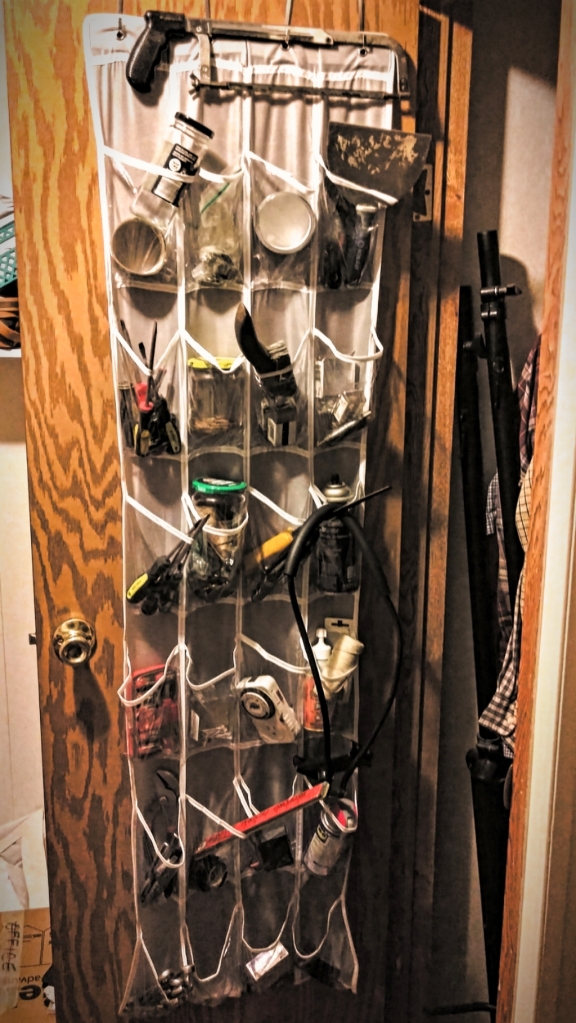
7. If I can’t touch it… I don’t really understand it. Soon it doesn’t exist.
Something about using my hands helps me remember, think, understand. This includes writing… If I write it, I remember it. (So does talking out loud to myself, btw.)
- I vastly prefer using index cards over ANY form of digital storage, as I point out above.
- If I simply handle the tools in one of my nooks… baking or writing… it can give me the desire to do. So I leave as many tools out to touch as I can. They can lend me motivation… simply by stroking them.
- I organize my work space around ease of touch. If I use a measuring cup or unbleached flour on a DAILY basis… I make sure they are within an easy arm’s length when I stand in my cooking nook. Same for my hammer on my work bench, etc. If I use a tool several times a WEEK, it must be within 2 or 3 steps. LESS, I make sure it is stored in plain sight somewhere within the room or work nook. Less than MONTHLY…? Do I really need it?
- I obsessively containerize… in transparent containers like jars. Objects with similar uses belong together. In my mind… and in my living space. And grabbing one jar with all the screw drivers I might need for one project works better with my autistic mind than selecting just the three I want. And then putting them away. Too much fussy detail. Too many chances for frustration. Or loss.
Resource articles for further reading:
“Major indoor triggers include irritants such as paints, cleaning agents, pesticides, and perfumes (both personal from toiletries and from deodorizers) as well as building materials such as sealants, plastics, adhesives, and insulation materials.”
Discussion of clumsiness and apraxia
Discussion of insulation from sensory input from in the environment. Dividing areas into for certain activities. Indirect lighting. Easy navigation. Quiet rooms & safe spaces.
“Inside the home, predictability can be a big deal to some on the spectrum. Each room should have an obvious purpose, transitions between rooms should be smooth and their boundaries should be clear. This may help an autistic person establish routines and increase independence, while minimizing anxiety.”
Support AutisticAF.me here: Paypal · Ko-Fi · Facebook Pay “Johnny Knapp Âû“

UPDATE 12/26/20
G-d I hate my autism today…
Listen, I screwed up big-time in my Christmas Eve post, “Designing My Home Around Adult Autism: 7 Principles.”
I completely left out why I thought the post was worth reading in the first place…
And, that’s why I’m posting this update with its own announcement… so folks who read it then… will see the update… now.
“Designing My Home” was 3,200+ words long… 10 times longer than my comfort zone for keeping my writing coherent. So you know, I fucked up.
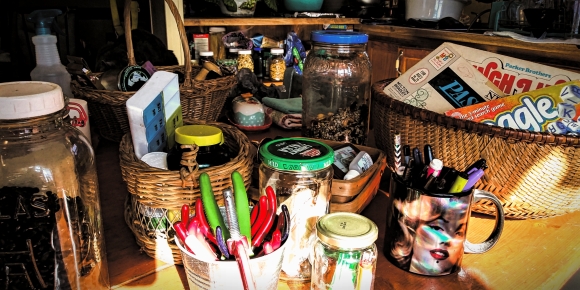
Here are the missing points:
- Containerization is very central to what works for me. I didn’t make that clear.
Because I don’t handle many details at once well… but I am gifted at focusing on one detail at a time…
I need to see, or more accurately, perceive as few objects as possible at a time. (Honestly, that’s true of all my senses… as well as thoughts & emotions….). AND as I did explain, I need to be able to clearly see things to remember I have them.
Grouping tools, ingredients, or related things into jars, baskets, shallow boxes, open bowls…. allows me to focus on a few categories of things at a time, but have easy access to all the “deatils” I need if I focus on the contents.
Short version: Two or three orderly baskets of things distract me vastly less than a corner stuffed with an overwhelming number of baking ingredients.
So I put screws in small, clear, lidded glass jars. Food in large jars. Board games in big baskets on visible shelves. Night time stuff… like glasses, jewelry, phone, pocket contents, eye drops… in a small basket beside my bed. I have one box for my usual pair of slippers, walking & stage shoes by my bed. I have one boot tray in my entry way for one pair each of garden & walking boots.
But honestly… the REALLY important detail I left out was this… - I wanted to show you my lifelong, hard-earned LITERAL survival strategy.
Hospitalized 3 times for suicidality… before I learned no hope there…
Family members, loved ones, or hired professionals have dug me out of rooms or apartments that I’d filled with stuff & trash… I believe… 6 times. Over the course of nearly 4 adult decades. Because I was either physically or mentally unfit to do so myself. Sometimes both.
My breezy writing style, while kinda good at talking about tough realities with a sense of normalcy, hope, and maybe pride… and portraying how my autistic mind works…
Gave some folks the impression I was “celebrating” some cute, comfortable lifestyle choice or peculiar hobby of a quaint old neatness freak with too much time on his hands.
NO. It is true these ideas helped keep me alive.
It is also true that there is an exactly zer0 percent chance anyone who has ever lived with me… or known me for a significant amount of time… would call me a “neatness freak.” Except in mockery. LMFAO
But. I’m still alive. - Okay this is really “inside baseball”…. the kind of thing only insiders care about.
Say, for folks who bump into the “Culture Wars” in the autistic community. A term I’ve usually seen used by professionals or consultants who specialize in counseling non-autistic parents of autistic children… to dismiss activists, advocates, authors and such who embrace the rather fuzzily defined concept of “neurodiversity”… as so many do… including me to whatever small extent I contribute.
Sometimes cruelly labeling folks who talk about neurodiversity as “bored Millennials indulging themselves with the latest identity fad that explains their personal failures.” (A near quote of something on LinkedIn.)
But, TRIGGER WARNING. I’m about to go off. And certainly offend…. some body…
<rant mode>
Enough of this shit.
Lately, I have received a few… but pointed, but painful… personal attacks or snidely, clever shade. The main thrust? By writing about my “high-functioning,” privileged life I am harming parents of autists and differently abled autists — who are the “real” autists…
Or, on the other hand, I’m threatening the cause of neurodiversity itself.
Ok.
This is my life. I will write about it as I please. If it doesn’t please you… Do. Not. Read. It.
I do not claim to have any truth but my own. I urge no course of action on anyone. I make no claims to any credential other than my own personal authenticity. I do NOT claim to represent anyone other than myself… certainly not speak for all nonspeaking, colors, “high-functioning,” “low-functioning,” gendered, sexually oriented, sub-types of autism… or any cause whatsoever.
And I do not compare my personal challenges, tragedies, strengths or triumphs to any other living being’s on the planet. There is no prize for “most disabled.” A person with one leg is not required to be silent because there are people with no leg.
Pain is pain. No degree of pain that damages life is good in my eyes.
Good God. I hate the human tendency to see every statement about oneself… positive or negative… as an implied criticism of or competition with you personally…
Or the inability to conceive that other humans may have legitimate needs that they have a right to pursue… and yet have no intention to harm you even if they conflict with your needs for professional identity… or income.
We could use our energies to pursue to meet both our needs collaboratively….
I simply hope, like so many experiential writers… even amateur ones… that in writing about my specifics there is something of the universal to be learned for somebody.
I do not accept that telling my truth… whether I am right, wrong, or indifferent in anybody else’s eyes… distracts from or damages any other individual on the planet with any other form or degree of disability.
At least not to any greater extent than any other writer on any other topic… whether abled or disabled.
I don’t want to compete. I want to support. I want to collaborate….
As I am able.
So…
Don’t like me. Don’t hang. And I report and publicize whatever I consider to be hate speech directed at me personally, any group of disabled folk, or anyone else. Regardless of what you see as your good intention.
</rant mode> - Some of my friends are writers or other artists, some are autistic… and some talk with me about how the autistic creative process may be different for us than others. So for those who have that interest….
I talk sometimes about my difficulties with language & writing. Probably worth a post in its own right… a number of us autists seem to have them.
To the point: It’s hard for me to write an “article” much longer than 300 words. Very hard. And not lose a sense of coherence. Or get lost in detail and forget stuff.
Difficulties prioritizing… summarizing… generalizing… topic sentences… paragraphs… concept of time… getting lost in detail… difficulties projecting the emotional impact of language on many differing groups of humans… etc etc etc.
Any way… short blog posts, tweets, written-word memes, would-be epigrams, the occasional poem… I can do that.
Much longer? I’m lost.
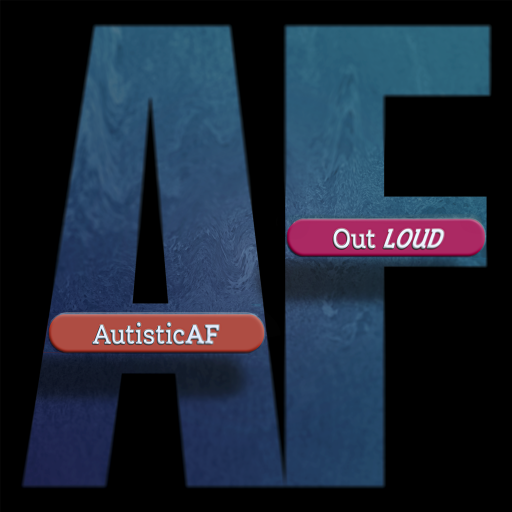

Leave a comment